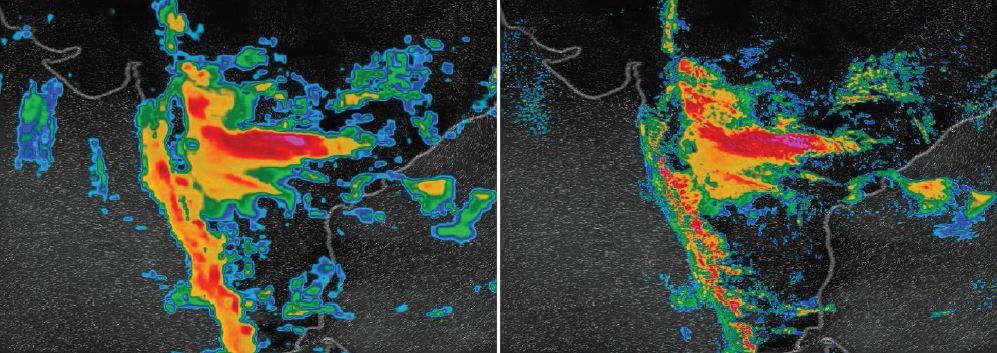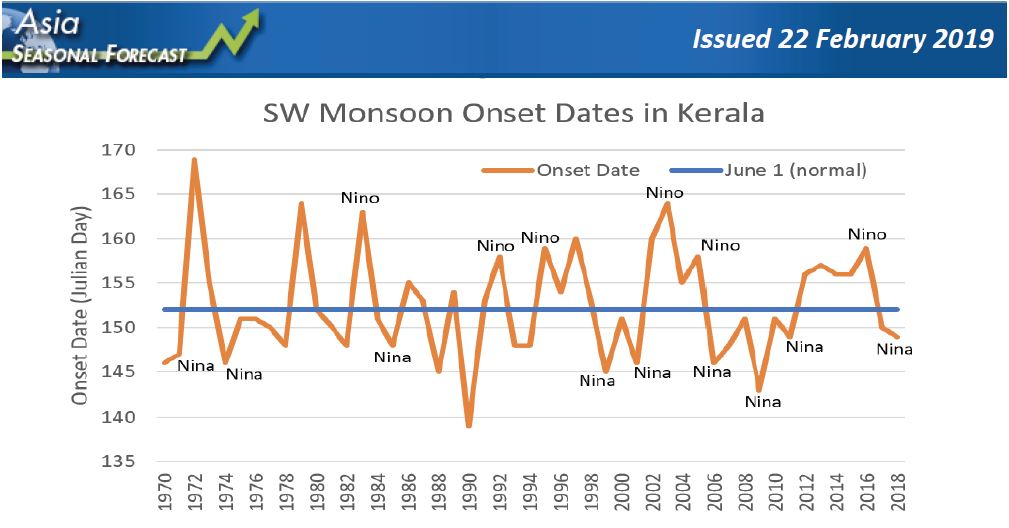
During an unseasonal rain in April 2018, farmers in the districts of Punjab, Haryana, Rajasthan and Uttar Pradesh lost a quarter of their crops on the eve of harvest. To make matters worse, the crops that survived the rainfall suffered from inferior grain quality.
Similarly, farmers who cultivated wheat saw pre-monsoon changes seriously impact their produce. In the states of Jharkhand, Orissa and Chhattisgarh, the rice yield experienced several losses during drought months.
Agriculture and climate have depended on each other for ages. Any change in weather directly impacts farmers and crops across the country. To optimize yields, farmers must make pre-season and in-season decisions based on what type of weather they expect.

Watson AI can provide farmers in India with intelligent solutions that provide personalized, actionable weather insights.
But imagine a scenario in which weather insights derived from artificial intelligence (AI) were integrated into every farming decision.

IBM Watson Decision Platform for Agriculture can help growers and enterprises in India reap the benefits of technology and innovation. This IBM solution combines advanced capabilities of cloud, AI, analytics and Internet of Things (IoT) with accurate weather forecasts and data collected from an abundance of farm equipment, remote sensors and environmental information to help farmers make faster, more informed decisions.
First comes reliable weather forecasts
If you look at data from the farmers’ Kisan Call Centres in India, in the last 2 – 3 years, over 65 percent of the calls made by farmers were regarding weather forecasts.
IBM’s announcement of the new IBM Global High-Resolution Atmospheric Forecasting System (GRAF) is the first hourly-updating commercial weather system that can predict something as small as a thunderstorm, virtually anywhere on the planet. Compared to existing models, GRAF can provide a nearly 200 percent improvement in forecasting resolution for much of the globe (12 – 3 km; 7.5 – 1.2 mi.) GRAF is expected to be available later in 2019.

An August 2018 monsoon in India, shown at left by the best current weather model that operates at 13-km resolution. At right, the new IBM GRAF operates at 3-km resolution and updates 6 to 12 times more often. IBM News Room, 8 Jan 2019/PRNewswire
GRAF uses advanced IBM POWER9-based supercomputers, crowdsourced data from millions of sensors worldwide, and in-flight data to create more localized, more accurate views of weather globally.
Today, outside of the United States, Japan and a handful of other countries primarily in Western Europe, the rest of the world must settle for less accurate forecasts for predictions that cover 12- to 15-kilometer (7.5 – 9.3 mi.) swaths of land — too wide to capture many weather phenomena. And, traditionally, leading weather models update less frequently, only every 6 to 12 hours. In contrast, GRAF will provide 3-kilometer (1.86 mi.) resolution that updates hourly, delivering reliable predictions for the day ahead.
The new system will be the first to draw on untapped data such as sensor readings from aircrafts, overcoming the lack of specialized weather equipment in many parts of the world. It will also give people the opportunity to contribute to helping improve weather forecasts globally because it can use pressure-sensor readings sent from barometers found in smartphones of users who opt-in to share this information. The Weather Company, an IBM Business, will assure it conforms to the relevant operating systems’ terms of use. Additionally, hundreds of thousands of weather stations, many that are run by amateur weather enthusiasts, can also contribute data to the model.
Reliable India monsoon forecast
• Climate models have been consistent in indicating a dry May and June, which also implies a later-than-normal onset to the Southwest monsoon, as well as a quick transition to wetter-than-normal conditions by July.
• This dry-to-wet evolution is at least partially dependent on a potential transition away from El Nino conditions as the season progresses.
• Further, there is a multi-decadal scale dry monsoon signal, potentially driven by the warmer oceans and reduced ocean-land temperature gradient.
• Finally, the model predictions of Indian Ocean sea surface temperatures (SSTs) are indicative of a weakly positive phase of the Indian Ocean Dipole (IOD).
• While it is still too early to make quantitative predictions of May – September rainfall, the evidence suggests, (1) a later-than-normal onset to the season and (2) drier-than-normal season.
• For those who need deterministic forecasts, a forecast for 5 June onset and 95 percent of total monsoon rainfall for the season seem quite reasonable currently.
We are still three months away from the onset of the Southwest monsoon season, but interest in predicting the onset and total amount of monsoon-season rainfall is high and rising rapidly. Last year, in The Weather Company’s first attempt at this tricky endeavour, we were a bit too wet, predicting 101 percent of normal precipitation when the observed value was 91 percent (below). We did some things well, in particular, capturing the drier-than-normal mid-monsoon period, and predicting an earlier-than-normal onset. But, after a fast start, the threat of monsoons fizzled-out quickly, possibly because of a developing El Nino.

“Asia Seasonal Forecast,” Dr. Todd Crawford, Sr. Meteorological Scientist, The Weather Company, 22 Feb 2019
Timing onset is quite difficult, although there are some clear factors you can look at. The graph below shows a historical time series of monsoon onset in Kerala, with the average date of 1 June highlighted in blue. In the last 50 years, date of onset has ranged from 19 May (1990) to 18 June (1972). Much of the interannual variability is described by the state of El Niño-Southern Oscillation (ENSO) from the preceding winter, either El Nino (Nino) or La Nina (Nina). As shown in the graph, most of the early-onset years (for example, 2018) occurred after La Nina winters, and many of the late-onset years occurred after El Nino winters (for example, 2016).

“Asia Seasonal Forecast,” Dr. Todd Crawford, Sr. Meteorological Scientist, The Weather Company, 22 Feb 2019
Food security
Modern food companies face daunting challenges as they strive to cope with global environmental change while also meeting the increasing consumer demand for greater sustainability and higher food quality. IBM is helping the agriculture industry improve farming practices with AI-driven solutions that are designed to improve quantity and quality of crop yields through smarter farming practices.
The platform is based on an electronic field record (EFR) that integrates several disparate sources of IoT and farm practice data. The EFR is like an electronic medical record, but for a piece of farmland rather than a human body. This record provides a single source of truth for a farm, applying AI and advanced analytics to field-specific data to create hyperlocal recommendations.
Scope of AI for farmers in India
The government of India is now taking steps to deploy AI, IoT and data analytics in agriculture. The government’s key think tank NITI Aayog is bringing AI to farmers4 by using IBM’s smart technology solutions for the sector. The pilot project “precision agriculture” will provide near real-time advisories to the states of Bihar, Jharkhand, Assam, Maharashtra, Rajasthan, Madhya Pradesh and Uttar Pradesh.
The project aims to develop specific monitoring systems to help improve crop yields and savings. This includes combining weather forecasts with drone and satellite imagery to aid in predicting and detecting pests and diseases so that corrective actions can be taken. This also helps farmers develop better strategies for pesticide use while reducing the environmental impact and lowering overall production costs.
As a result, crop producers are seeing their agricultural activities in a new light. Greater visibility into the likely quality and quantity of a yield improves transparency across the agriculture ecosystem, enabling stakeholders in various roles — including growers, producers, traders and insurers — to respond accordingly. Understanding critical factors such as soil temperature, moisture, pest and disease risk can also allow farmers to make better decisions about planting, irrigation and fertilization.
The solution also uses AI to help farmers identify when to sell their crops by suggesting the best time to maximize profit. With IBM PAIRS Geoscope technology, growers can also apply geospatial-temporal information to help companies make predictions about the future of their farms.
Relying on traditional knowledge and methods may no longer be enough to meet the challenges facing modern agriculture. IBM Food Trust infused with IBM Watson Decision Platform for Agriculture is designed to provide decision-support capabilities to a host of organizations around the world. In each case, an AI-efficient food chain can support better crop quality and sustainability to help farmers feed us every day.
Endnotes
1 “Unseasonal rain damages crops in north India,” The Economic Times, 14 Apr 2018
2 “Bringing the power of Watson to farmers,” by Ulisses Mello and Sriram Raghavan, Smarter Farms: Watson Decision Platform for Agriculture, 24 Sep 2018
3 Open Government Data (OGD) Platform India – data.gov.in
4 “Govt aims to harness big data, AI in agriculture sector,” Hindustan Times, 13 May 2018
5 “IBM PAIRS Geoscope delivers an integrated data platform for geospatial data used for advanced and AI driven analytics,” IBM United States Software Announcement 218-556, 13 Nov 2018
6 “Bringing new clarity to food supply complexity,” IBM Food Trust: trust and transparency in our food
© Copyright IBM Corporation 2019
IBM, the IBM logo, ibm.com, IBM Watson, the IBM Watson logo, POWER9, and Watson are trademarks of International Business Machines Corp., registered in many jurisdictions worldwide. The Weather Company® and the Weather® logo are trademarks or registered trademarks of TWC Product and Technology, LLC, an IBM Company. Other product and service names might be trademarks of IBM or other companies. A current list of IBM trademarks is available on the web at “Copyright and trademark information” at http://www.ibm.com/legal/copytrade.
For details regarding compliance with applicable laws and regulations, see the IBM Terms of use website.
Be a part of Elets Collaborative Initiatives. Join Us for Upcoming Events and explore business opportunities. Like us on Facebook , connect with us on LinkedIn and follow us on Twitter, Instagram.











